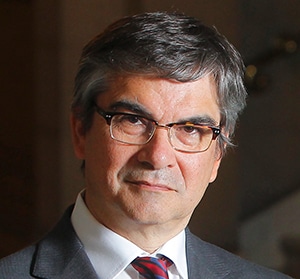Governor of the Central Bank of Chile shares insights withGlobal Finance.

Global Finance: What has been the impact of the Covid-19 pandemic on the Chilean economy? What are your expectations for the rest of 2020 and for 2021?
Mario Marcel Cuellell: As has happened throughout the world, the macroeconomic scenario is determined by the development of Covid-19 and the measures taken to protect the health of the population. After a sharp fall at the beginning of the second quarter, registering a drop of 14.1%, the Chilean economy in recent months has shown signs of stabilization, an incipient improvement in some sectors, such as commerce, and deterioration in others.
For the rest of 2020, the greatest challenges are to reverse the loss of jobs, the decline in household income and the deterioration of consumption and maintain a flow of credit in line with the needs of working capital and investment of companies. The CBC will continue to maintain a highly expansionary monetary policy and will continue to be vigilant to prevent risks to financial stability.
GF: What has the Central Bank of Chile been doing to support the economy and contain poverty during the current recession?
Marcel: The CBC has adopted a series of measures aimed at providing liquidity to the markets and stimulating the flow of credit to the productive sector, in order to avoid a more severe disinflationary cycle and prevent risks to financial stability, which could raise the economic and social cost of the current shock.
Over the past 10 months, the CBC has cut the policy rate by 125 basis points to its effective zero lower bound at 0.5%, and implemented a dozen measures to provide liquidity to markets and to foster lending to firms most affected by the lockdown. Credit measures amount to a combined 15% of GDP, mainly around a medium-term liquidity facility to banks, conditional on credit expansion—the so-called Facilidad de Crédito Condicional al Incremento de las Colocaciones (FCIC) program. This scheme provides four-year loans at the 0.5% policy rate, conditional on growth in corporate and consumer lending, increasingly weighted toward small and medium-size enterprises (SMEs).
The response of bank credit has been largely positive. Corporate lending has been growing at a double-digit rate in real terms, year-on-year, over recent months, making it the first case of countercyclical lending in recent history. In particular, banks have used liquidity to allow the drawdown of credit lines by corporations, 1.2 million rollover operations and 180,000 working-capital loans with an SME share largely above historical averages. Long-term interest rates have responded well to monetary policy decisions, forward guidance and nonconventional tools.
In June, the CBC resolved to establish a second program for a global amount equivalent to $16 billion, with financial conditions similar to the first facility, aimed at deepening and extending commercial credit to respond to the prolongation of the health emergency. Also, at the CBC’s request, the IMF granted access to a Flexible Credit Line (FCL) equivalent to nearly $24 billion, a figure greater than 60% of the International Reserves, valid for two years. With this, to a total of 92.2% International Reserves—which is a level similar to China, Indonesia, Hungary and Turkey—there are added 51.4% of sovereign wealth funds and 55.1% of FCL (totaling 198.7%).
GF: How is Chile doing in comparison to the region?
Marcel: The evolution of infections depends, to an extent, on the living conditions of the population, which are heterogenous in the region in terms of sanitary conditions, shelter and socioeconomic status. In this regard, Chile found itself relatively well placed, with an adequate supply and rapid replacement of medical equipment that has prevented a collapse of the health network. [In Chile] the virus reproduction rate is below one, after being among the highest in the region.
The majority of Latin American authorities imposed strict confinement measures, many of them before other governments in the world, causing significant drops in the mobility of people in April, which has tended to recover since then. However, the dynamics of contagion in the region still look complex, with a majority of countries still not reducing the curve of contagion.
The economic crisis found the region in an unfavorable situation for an aggressive fiscal response. Despite this, some countries, such as Brazil, Chile and Peru, have announced important fiscal measures as a percentage of GDP (6.5%, 7.7% and 8.1%, respectively).
The response from central banks has been aggressive. In many cases, policy rates are estimated to be in negative territory, for example, for Chile, Colombia and Peru. The developments in financial markets suggest that the actions of monetary authorities managed to control volatility in the markets, although with a higher level of risk for the entire block of emerging economies. Monetary policy has allowed credit to behave countercyclically in the region, as has been observed in advanced economies. In the case of Chile, this has been a distinctive element in contrast to previous crisis episodes, in which commercial credit had a pro-cyclical dynamic.
In this sense, the support of public policies, including central banks, will be essential to sustain the recovery. This crisis will leave important marks that serve as a unique opportunity to learn fundamental lessons for the future.



